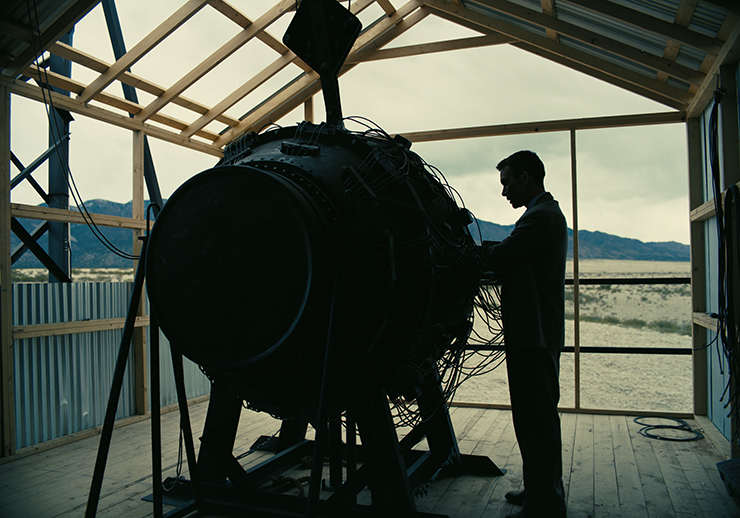
Cillian Murphy as J. Robert Oppenheimer in a scene from "Oppenheimer." (Photo courtesy of Universal Pictures).
“Oppenheimer,” Christopher Nolan's mammoth and exhausting portrait of the father of the atomic bomb, desperately wants to impress you, but it's too high on its own fumes to make good on its lofty ambitions.
The “Inception” auteur's first effort after parting ways with Warner Bros. adapts the Pulitzer Prize-winning Oppenheimer biography “American Prometheus” for the screen (the bigger the better). It detonates all sorts of conflicting emotions, but let's go with the top two: awe at its visual splendor and impressionistic cadences, and frustration at its stubborn insistence in stitching together two films in one. There's the one you probably came to see, which is the story of a team of brainy academics brought together to create a weapon of mass destruction before those across the Atlantic do, and thus secure a victory for the Allied powers during World War II. But the Universal release also springs forward several years to offer a glimpse at the political fallout, lathered in backstabbing and guilt, from those twin mushroom clouds.
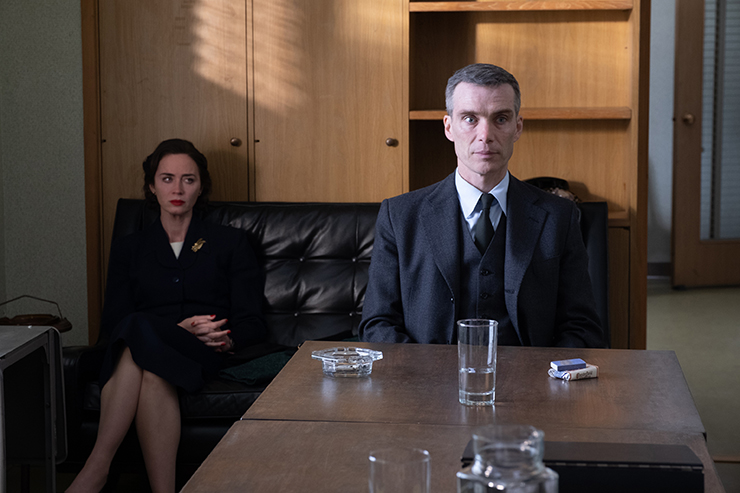
Emily Blunt as Kitty Oppenheimer and Cillian Murphy as J. Robert Oppenheimer in a scene from "Oppenheimer." (Photo by Melinda Sue Gordon/Universal Pictures).
The latter narrative strand initially appears to serve as a framing device for the first one. It's mostly comprised of a series of hearings in 1954, behind closed doors, by the Atomic Energy Commission, in order to determine whether J. Robert Oppenheimer, now nearly a decade removed from his best-known accomplishment, will retain his security clearance. The hearings provide Nolan with an engine to hone in on Oppenheimer's public and private life. The bulk of “Oppenheimer” unfolds in these artfully crafted flashbacks, bolstered by quick cuts, stream-of-consciousness links between different moments in time, set to the relentless drone of Ludwig Goransson's wall-to-wall music score. It's an ornate fever dream that metastasizes into a nightmare, in ways that are initially thrilling but ultimately draining. You feel your enthusiasm ebb away.
Nolan takes us as far back as Oppenheimer's days in Cambridge, where a student with disdain for mathematics and lab work meets fellow travelers who will prove to be pivotal figures in the years to come. That apt but restless pupil, played as a young man and as the eventual agent of destruction by Cillian Murphy, is encouraged by Danish physicist Niels Bohr (Kenneth Branagh) to complete his doctorate at the University of Gottingen in Germany.
Oppenheimer meets fellow theoretical physicist Werner Heisenberg (Matthia Schweighofer). Both men are mutual admirers, fully unaware they would be on opposing sides on the arms race in the coming conflict. Serving as a conscience and a welcome source of warmth for our driven protagonist is fellow physicist Isidor Isaac Rabi (a nearly unrecognizable David Krumholtz, quietly becoming one of the movie's MVPs).
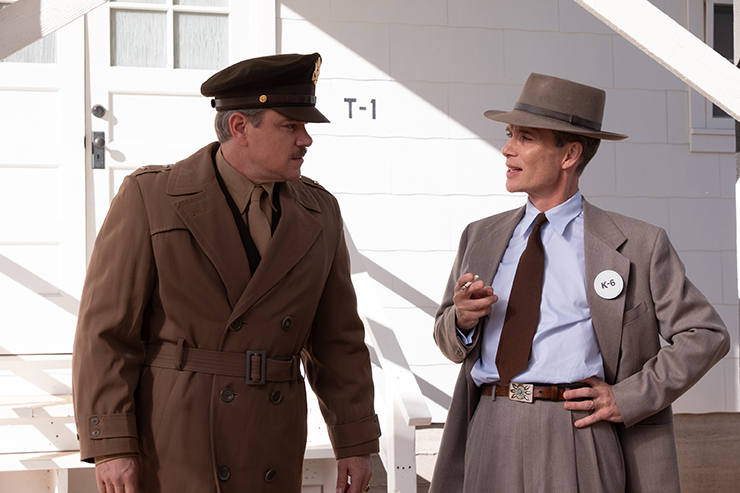
Matt Damon as Leslie Groves and Cillian Murphy as J. Robert Oppenheimer in a scene from "Oppenheimer." (Photo by Melinda Sue Gordon/Universal Pictures).
“Oppenheimer” could have used more of the modesty that the pudgy Rabi, with his maternal instinct to remind the rail-thin Oppie to “eat, eat,” brings to the table, but Nolan forges ahead as if he's making the cinematic equivalent of the great American novel. Back on U.S. soil, Oppenheimer's associations include members of the Communist Party, though he keeps his distance. He begins a sordid affair with Jean Tatlock (Florence Pugh), a party member who happens to be a married woman, before he meets Kitty (Emily Blunt), the woman he would eventually wed. Rare (for Nolan) glimpses of lovemaking ensue, climaxing with a surreal flourish later in the film that draws unintentional laughs. Nolan may not be afraid to show sex on screen (though Murphy shows conspicuously less skin than Pugh), but the director remains a bit of a square in that department.
The women in Oppenheimer's life present an opportunity to further develop the character, but Nolan reduces Tatlock to her sexuality and self-destructive behavior. Kitty fares even worse; Nolan leads by showing a flask or cocktail glass before acknowledging she exists. It's a glaring lapse for a film that attempts to cover all the bases in its central figure's life, and anyone familiar with Nolan's work will know it's not the first time he's reduced his female characters to plot devices to drive the men's stories forward. (See also: “The Prestige.”)
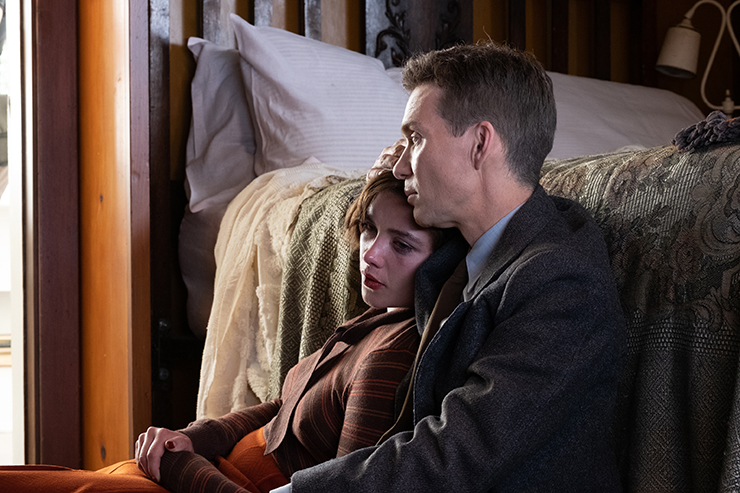
Florence Pugh as Jean Tatlock and Cillian Murphy as J. Robert Oppenheimer in a scene from "Oppenheimer." (Photo by Melinda Sue Gordon/Universal Pictures).
But “Oppenheimer” can't stop, won't stop, and after overcoming several hurdles, Uncle Sam comes knocking, in the form of U.S. Army Lt. Gen. Leslie Groves (Matt Damon), the Corps of Engineers officer who directed the ultra-secret Manhattan Project. The verbal sparring between Oppie and Groves, leading to Oppie spearheading the Los Alamos Laboratory in New Mexico, is one of the film's highlights.
The fireworks that the characters' arguments generate, acted to perfection by the stars, go against the rest of the film's eat-your-veggies approach to 20th-century history, thus underscoring the need for “Oppenheimer's” against-the-clock Manhattan Project scenes to be their own movie, unencumbered by the added weight of the film's cause-and-effect framing. (Several scenes involving Oppie and Albert Einstein, well played by Tom Conti, attempt to weave in both timelines, but they're not enough.)
To give credit where credit is due, Nolan nails the “money shot” sequence: the do-or-die nuclear test that proved beyond the shadow of a doubt that the atom bomb would serve its lethal purpose and bring the war to an end. But then it dawns of you that the movie's not quite done. Not even close. In what feels like an additional hour (it's a bit less, but goodness, you feel the length), “Oppenheimer” returns to the 1954 hearings and dives headlong into the ripple effects of the Hiroshima and Nagasaki bombings.
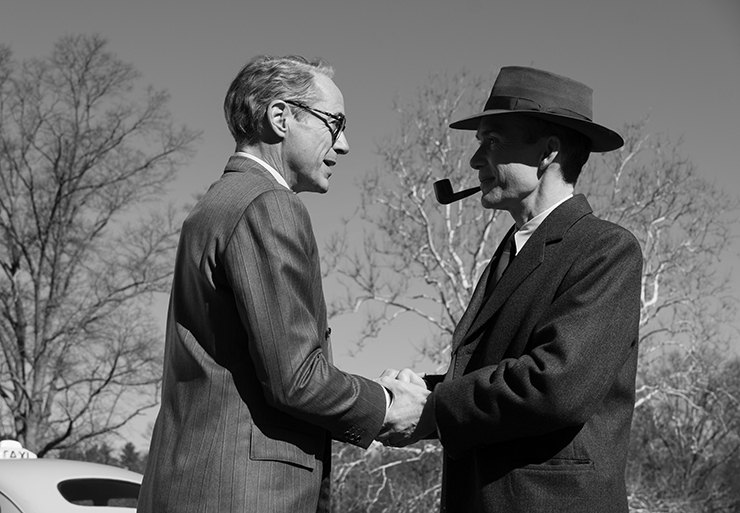
Robert Downey Jr. as Lewis Strauss and Cillian Murphy as J. Robert Oppenheimer in a scene from "Oppenheimer." (Photo by Melinda Sue Gordon/Universal Pictures).
This is when the spotlight shines on Robert Downey Jr.'s Lewis Strauss -- businessman, philanthropist, naval officer, member of the Atomic Energy Commission and ostensible helping hand to an embattled Oppenheimer besieged by attacks on his character. Downey takes the juicy role and runs with it. The “Iron Man” star helps anchor several scenes (shot in IMAX black and white, a first for Kodak) where Strauss, up for a Cabinet post in the Eisenhower administration several years after the AEC Oppenheimer hearings, is grilled by senators about Oppenheimer and the nuclear program.
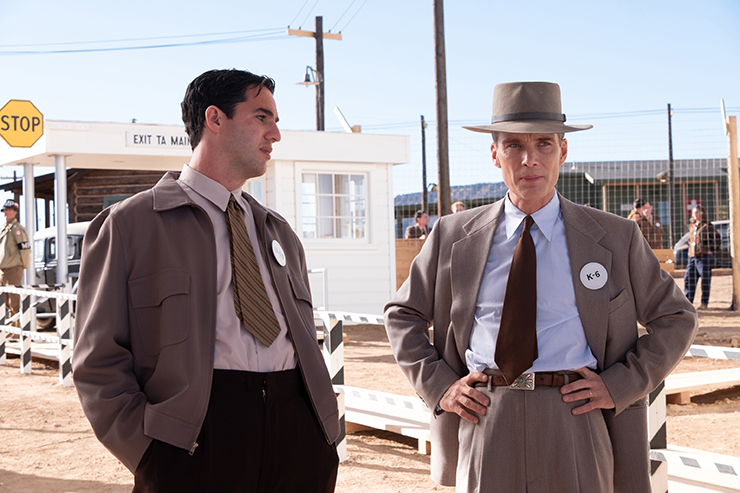
Benny Safdie as Edward Teller and Cillian Murphy as J. Robert Oppenheimer in a scene from "Oppenheimer." (Photo by Melinda Sue Gordon/Universal Pictures).
Taken on their own, the 1950s scenes are a gripping if somewhat naïve and simplistic, portrayal of politics as a Darwinian game of chess. They also swallow the film whole, dampening the excitement we feel as this group of scientists pull off the seemingly impossible. “Oppenheimer” would have benefited from a splitting of atomic particles, or in this case, narratives into two different films.
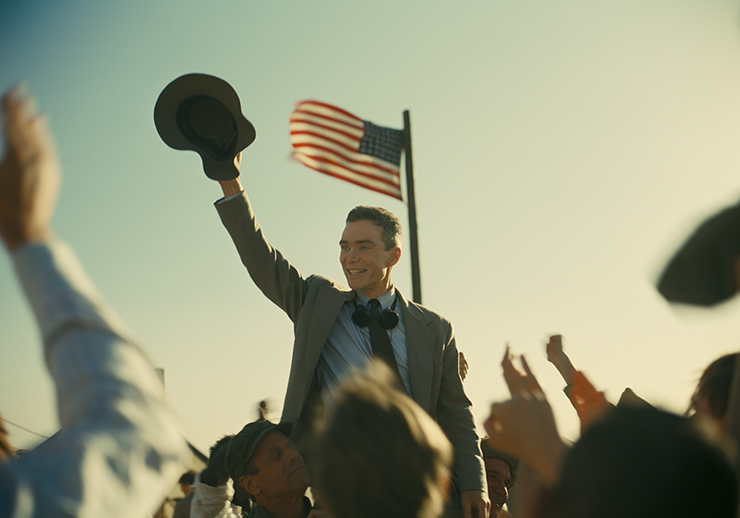
Cillian Murphy as J. Robert Oppenheimer in a scene from "Oppenheimer." (Photo courtesy of Universal Pictures).
Subtlety is not a Nolan specialty, and “Oppenheimer” fuses his strengths and self-indulgent tendencies into a maelstrom of sound and fury that bring to mind Oliver Stone in full-tilt “JFK” mode. Some of the intricate cross-cutting also recalls Terrence Malick, “The Tree of Life” in particular, but Nolan and his bells and whistles lack Malick's humility before the infinite. To be fair, “Oppenheimer” is a sizable step up from “Tenet,” Nolan's impenetrable 2020 thriller that's toppled by its convoluted time-hopping spy games.
But his latest effort is too much of an endurance test, a magnum opus consumed by its quest for significance. Caught in the middle is a uniformly strong cast made up of too many other familiar faces to name here. As for Murphy, the “Peaky Blinders” star rises above the chaos. It's a pity the movie ends up imploding, its adroitly conceived puzzle pieces coming apart in a rain of noble intentions and unmitigated ego.
“Oppenheimer” is now showing across South Florida, including 70mm engagements at AMC Aventura and Coral Gables Art Cinema, as well as the only Florida engagement in IMAX 70mm at the Museum of Discovery and Science's AutoNation IMAX in Fort Lauderdale.




